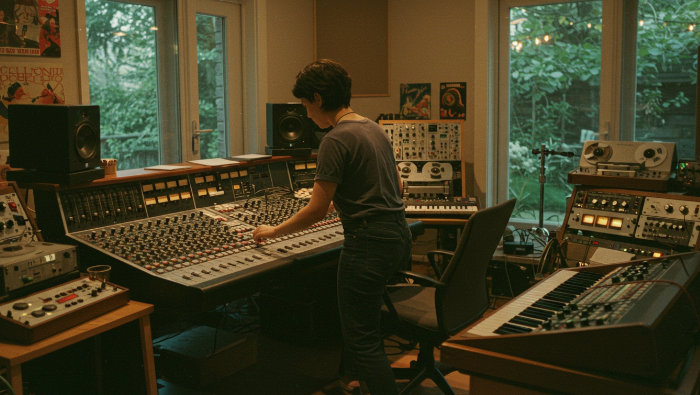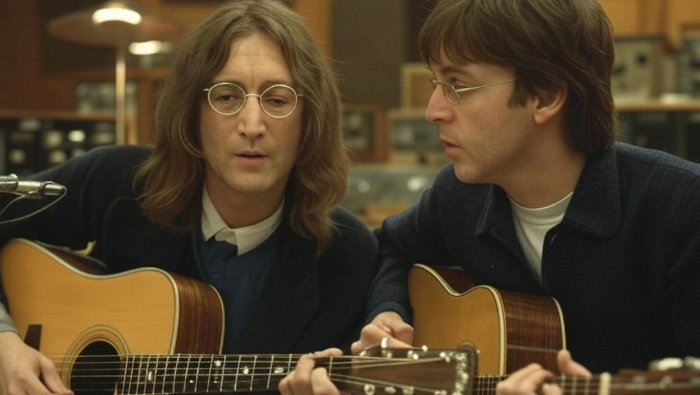HSS Podcast - Start Mixing in Mono: The Secret to Elevating Your Home Studio Sound
HSS Staff
Imagine this: you’ve just wrapped up an incredible recording session in your home studio. The tracks sound absolutely lush in your headphones, layers blend seamlessly, the bass thumps with warmth, and the vocals sit perfectly in the pocket. But, as soon as you hit play on a different set of speakers—yikes! The balance is all off; your impeccable mix has suddenly turned into an unruly hot mess. Feeling like you’re on an emotional rollercoaster ride?
That’s where mixing in mono enters the picture, stealthily saving the day like a masked vigilante. It’s a game-changer—a superpower you never knew you needed. While it might seem counterintuitive to restrict your stereo soundscape, starting your mix in mono holds magical powers that can transform the way your music communicates to every single listener, on every single speaker. Intrigued yet? Dive into this post and unlock the secret to pristine mixes that stand the test of every playback device.
1. Understanding Mono vs. Stereo Mixing
Mixing in mono might sound like stepping back in time, but it’s actually a secret weapon for home studios everywhere. To truly appreciate why mixing in mono is a game-changer, it’s essential to understand the difference between mono and stereo mixing.
Mono Mixing: The Basics
Mono, short for monophonic, means using a single audio channel. Imagine listening to music through a single earbud; that’s your mono experience. In mixing, this approach forces you to focus on the core elements of your track, such as balance and frequency distribution. Why does this matter? Because if a mix sounds great in mono, it’s likely to sound even better in stereo.
Stereo Mixing: A Broader Perspective
Stereo adds dimensionality to your music with two channels, creating a sense of width and space. This is akin to having two earbuds, where sounds can move left and right, giving listeners an immersive experience. However, the added complexity can sometimes mask imbalances that a mono mix would reveal.
Real-World Application
Consider the Beatles, legends who often mixed in mono. Their mono mixes were tight and focused, ensuring that all elements blended harmoniously. For home studios, start by perfecting your track in mono. This ensures that the bass, drums, and vocals are balanced. Once satisfied, switch to stereo to add depth and spatial effects, like reverb and panning.
Practical Tips
To mix in mono, use your DAW’s mono switch or add a mono plugin to your master bus. Listen for any clashing frequencies or volume imbalances. Correct these issues before flipping back to stereo. This disciplined approach leads to cleaner, more professional-sounding mixes.
2. The Historical Context and Benefits of Mixing in Mono
The Roots of Mono Mixing
Mixing in mono might sound like a relic from the past, harking back to the days of vinyl records and AM radio. Historically, mono was the industry standard because stereo technology hadn’t yet been developed. Legendary artists like The Beatles and The Beach Boys initially released their early work in mono, crafting timeless albums that captivated audiences worldwide. They focused on delivering a balanced and cohesive sound, ensuring that every element of the mix was audible and impactful.
Why Mono Still Matters
Fast forward to today, and mixing in mono remains a vital technique in the toolkit of many seasoned producers. The primary benefit of mono mixing is its ability to expose phase issues and balance problems. When all sounds are collapsed into one channel, it becomes glaringly obvious if certain elements are overpowering or if instruments are phasing out.
Consider a scenario where you have two guitar tracks panned hard left and right. In stereo, they might sound full and rich, but when listened to in mono, they could potentially cancel each other out, leading to a thin and weak sound. By starting your mix in mono, you ensure that your mix will sound good no matter the playback system, from high-end speakers to simple mono devices like smartphones.
Practical Tips for Mixing in Mono
– Check Your Mix Regularly: Routinely switch your mix to mono during the process. This helps catch any phase issues early, making adjustments straightforward.
– Prioritize Balance Over Panning: Focus on achieving a clear balance where every instrument is heard without the aid of stereo panning. This discipline often results in a more coherent and punchy mix.
– Use Reference Tracks: Listen to classic mono mixes to understand how different elements can be balanced effectively. Songs like “Good Vibrations” by The Beach Boys are excellent examples.
In essence, mixing in mono provides a solid foundation, ensuring your music sounds excellent regardless of the listening environment. By understanding its historical significance and leveraging its benefits, home studios can elevate their productions to new heights.
3. Techniques for Effective Mono Mixing

Mixing in mono can seem like a daunting task at first, but with the right techniques, it can become an integral part of your mixing process. The key to effective mono mixing is ensuring that every element of your track is clearly audible and well-balanced, even when spatial cues are removed. Here’s how to achieve that.
3.1 Start with Levels
Begin your mono mix by setting the levels. This might sound basic, but in mono, it’s especially crucial. With panning out of the picture, each element competes for space more fiercely. Start by setting the volume for the most important element, such as the vocals or the lead instrument. Then, bring in other elements one by one, adjusting their levels so that everything sits comfortably together. For instance, try setting your vocal level first, then add the kick and bass, ensuring they don’t overpower the vocal.
3.2 EQ for Clarity
When mixing in mono, EQ becomes your best friend. Use it to carve out space for each element. For example, if your kick and bass are clashing, try cutting the low mids on the bass and boosting them slightly on the kick. This approach helps each element occupy its own frequency space, making the mix less congested. Practical tip: use a spectrum analyzer to visualize frequency overlaps and address them effectively.
3.3 Compression for Consistency
Compression helps maintain a consistent sound and can glue your mix elements together. In mono, this is particularly important as dynamics can become more noticeable. Apply gentle compression to your vocals to keep them steady in the mix, and consider bus compression for the drums to create a cohesive sound.
3.4 Check with Stereo
Finally, while mono mixing is an excellent technique, always check your mix in stereo. This ensures that your adjustments translate well once stereo panning is reintroduced. A mix that sounds tight and balanced in mono will likely sound great in stereo, with the added benefit of spatial separation.
By mastering these techniques, your mono mixes will not only sound clear and professional but will also lay a strong foundation for further stereo enhancements.
4. Common Mistakes and Solutions in Mono Mixing
Mixing in mono can be a game-changer for home studio enthusiasts, but like every learning curve, it comes with its own set of common pitfalls. Let’s dive into these mistakes and explore practical solutions to enhance your mono mixing game.
Ignoring Phase Issues
One of the most frequent mistakes is overlooking phase issues. When tracks are summed to mono, phase cancellations can occur, making some elements of your mix disappear or sound thin. Imagine working on a lush stereo synth pad only to find it almost inaudible in mono. To solve this, regularly check your mix in mono while working in stereo. Tools like phase meters and mono switches on your DAW can be lifesavers. Try flipping the phase of one channel to check if it improves the sound.
Overcrowding the Midrange
Another common mistake is overcrowding the midrange frequencies. In mono, all elements sit in the same space, which can lead to a cluttered mix if not managed properly. Picture a mix where vocals, guitars, and synths all fight for attention in the same frequency range. To combat this, employ EQ to carve out space for each element. Use techniques like subtractive EQ to remove unnecessary frequencies and allow each instrument to shine.
Lack of Dynamic Control
Dynamics can often be neglected in mono mixing. Without the stereo spread, the mix can easily become overwhelming if every element is at maximum loudness. Consider a drum kit where the kick drum and snare are competing for dominance. Utilize compression to tame peaks and create a balanced mix. Try parallel compression to maintain punch while controlling dynamics effectively.
By being aware of these common mistakes and applying these solutions, you can significantly improve your mono mixes, setting a solid foundation for a polished stereo mix later on.
5. Transitioning from Mono to Stereo: Enhancing Your Mix
Mixing in mono is like cooking with just salt and pepper; it’s straightforward and helps you focus on the essentials. But once you have a solid foundation, transitioning from mono to stereo is where the magic happens. This process allows your mix to breathe, offering a vast soundstage that can elevate your tracks from good to great.
The Power of Stereo
Imagine listening to a song where all instruments are stacked on top of each other. That’s what mixing in mono feels like. When you switch to stereo, it’s like spreading those instruments across a stage, giving each element its own space. This separation enhances clarity and allows each sound to shine.
Practical Tips for Transitioning
First, start by identifying the core elements in your mix. Perhaps it’s the vocals, bass, and drums. Place these elements in the center of your stereo field to maintain a strong foundation. Next, experiment with panning other instruments such as guitars, synths, or backing vocals. Panning them left or right can create an engaging stereo image.
For instance, in a pop track, try panning the rhythm guitar slightly to the left and the lead guitar to the right. This not only mimics the live band experience but also prevents clashing frequencies. Use stereo widening plugins sparingly to add depth without losing focus.
Case Study: Real-Life Application

Consider the classic Beatles track, “Come Together.” Initially mixed in mono, the stereo version utilizes panning to create an immersive listening experience. The drums remain central, while the guitars and vocals subtly move across the stereo field, enhancing the musical journey.
By transitioning mindfully from mono to stereo, you’re not just adding width but creating an emotional and immersive experience for your listeners. Remember to check your mix in mono periodically to ensure balance and coherence remain intact.
Conclusion: Mixing in Mono – Your Secret Weapon for Clarity and Consistency
Mixing in mono may seem like an old-school approach, but its benefits for modern home studio producers are as relevant as ever. By focusing on mono, we’ve highlighted how this technique can reveal hidden issues in your mix, streamline your mixing process, and ensure your music translates well across various playback systems.
First and foremost, mixing in mono forces you to concentrate on the essentials of your track. It ensures that your critical elements like vocals and bass drum have their own distinct space, free of frequency clashes, enabling a cleaner overall sound. As we’ve learned through examples, reduced phase cancellations lead to a more vibrant and unified stereo mix when you eventually switch back.
Moreover, adopting a mono mixing approach saves valuable time and effort. Instead of endlessly adjusting stereo fields to find that sweet spot, you’re able to make decisive edits that impact the core of your track. Real-world applications, like the story of the indie producer who improved mix quality by embracing mono, demonstrate the power of this tactic.
Finally, mixing in mono guarantees compatibility with a variety of sound systems, whether it’s a smartphone speaker or an elaborate home theater setup. We’ve explored how crafting your mix to sound good in mono ensures its accessibility, reaching more listeners with a consistent quality.
Ready to level up your mixing game? Start your next mixing session in mono and witness the transformation in your sound. Embrace this technique, hone your ear for detail, and watch as those nuanced improvements translate into a captivating listening experience. Jump into mono, focus on the fundamentals, and join the ranks of savvy producers who know that sometimes, less is undoubtedly more.
Let us know your experiences and how this shift helps transform your production game by commenting below or reaching out through social media. We can’t wait to hear your newfound clarity!

